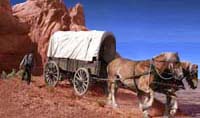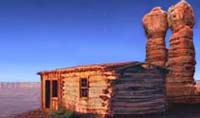 Return to Biography Selections
Return to Biography Selections |
 Download a Printable
Download a Printable
PDF File |
Mary Elizabeth Fretwell Davis
Born: 14 April 1843; London, Middlesex, England
Died: 22 November 1928; Bear Lake, Idaho
Married: Henry James Davis; 23 April 1864
Father: William Killingley Fretwell
Mother: Mary Ann Raby
Early Life and Conversion
Mary Elizabeth Fretwell Davis was born on April 14, 1843, to William and Mary Fretwell. She was the oldest of seven children. In her autobiography, Mary Elizabeth recorded that her father initially held a good position and raised his family in a comfortable home. When Mary Elizabeth was four of five, however, the family suffered some financial troubles and “had to move to poorer quarters.”i Although William Fretwell was no longer able to send his children to a public school, he and his wife spent a considerable amount of time educating their children at home.
During the summer of 1852, Latter-day Saint missionaries visited the Fretwell home in London. The family quickly adopted the missionaries’ teachings. Mary Elizabeth recorded that her parents reportedly “‘felt a serene and beautiful influence’” and “‘became convinced that the gospel with all its gifts and graces had indeed been restored.’”ii In the spring of 1853, the Fretwell family was baptized. Mary Elizabeth later recalled that these were happy times for her family, as her father found additional work. Tragically, on February 6, 1858, Mary Elizabeth’s mother passed away at the age of 36. With her father left grief stricken, and at times depressed, Mary Elizabeth assumed many of the household duties and quickly went to work making shoes and boy’s suits. Although the work was difficult, Mary Elizabeth recalled with satisfaction that the work brought in eight shillings a week.
Emigration
As Mary Elizabeth grew older she desired to travel to the United States to join with the rest of the Latter-day Saint movement. Carefully putting aside money each week, she was soon able to afford the passage. On June 4, 1863, Mary Elizabeth sailed from London, remarking later that she “felt very sad as we sailed away and I saw old England and those I loved fading out of sight, not knowing if I would ever see them again.”iii The ship arrived in New York harbor on July 18,1863. Continuing her journey with many of the same immigrants she sailed with, Mary Elizabeth traveled the rest of the journey to Missouri by boat and rail car. After arriving in Omaha, Mary Elizabeth joined up with a wagon train heading to Salt Lake City, which departed on August 6, 1863. She was initially unaccustomed to prairie living. It was only after several failed attempts and a little observation that Mary Elizabeth learned how to bake bread in a bake kettle. Although the trip was long, she enjoyed the “promenading” and “dancing in the corner” that the company enjoyed in the evening.iv The wagon train arrived in the Salt Lake valley on October 4, 1863.v
Salt Lake City
After their arrival, Mary Elizabeth and the rest of the company visited with Brigham Young and were soon integrated into the community. Mary Elizabeth enjoyed Salt Lake City, especially the plentiful peaches that many settlers grew in orchards. After initially boarding with a “mad woman,” Mary Elizabeth went to live with a Sister Lee, who treated her nicely. She lived with Sister Lee that winter until she was reunited with James Davis, an immigrant she had known in London. The two courted and were married on April 23, 1864, in the Endowment House in Salt Lake City. James and Mary Elizabeth quickly moved to James’s farm in Cedar City. In one autobiography, Mary Elizabeth recorded that “for the next twenty years I was to endure many trials, tribulations and hardships.”vi Mary Elizabeth and James’ first home was a dugout in Cedar City, followed shortly by a crude log home. It was there that their first child, Mary, was born. She died approximately two months after birth. After her daughter’s passing, Mary Elizabeth sent a tender letter to her father in England, which illustrates her faith and fortitude: “I felt a great grief at losing [the baby], after all my suffering but the Lord gave her to me and He has taken her away and I know if we do right we shall have her again, that is the only thing that gives me consolation.”vii Eventually, eight more children would be born to James and Mary Elizabeth in Cedar City.
Hole-In-The-Rock Expedition and Later Life
Early in 1879 Mary Elizabeth and James received a mission call from Latter-day Saint leaders to settle along the San Juan River. The Davis family was to be part of the initial exploring party (along with the Harriman family and some exploring scouts), which was to precede the larger Hole-in-the-Rock expedition. Their mission, under the direction of Silas S. Smith, was to establish a settlement on the San Juan River and befriend the Indian tribes in the area (Navajo, Paiute and Ute peoples). Despite Mary Elizabeth’s poor health and the fact that she “felt badly at leaving our comfortable home” the couple sold their possessions and left on April 13, 1879. She recorded: “After three months of traveling through dry, sandy, rough desolate country and constantly being in fear of the Indians we arrived at the San Juan about the middle of July, 1879.”viii
James and Mary Elizabeth, with help from other members of the exploring party, settled at Montezuma Creek. They began immediately to tame the desolate landscape. To provide protection against Indians, the men built a small enclosure named Fort Montezuma. This crude structure was made out of cottonwood logs and had a mud roof and no floor. James and Mary Elizabeth were given a small room in the fort. Although the fort provided needed protection from hostile Indians and the elements, the settlers were unable to secure a harvest as valuable planting time had been used in building Fort Montezuma.
The Davis family faced trouble with Indians before they were able to move into the fort. On one occasion, an unfriendly Navajo named Peokan “entered their camp while they were eating, and kicked dirt into their food, then took their knife, sharpened it on a rock and pulled it across his throat, as an indication of his intent.”ix Although a fight was avoided, partly thanks to James Decker, another San Juan settler accompanying the group temporarily, the Davis family had to flee the area quickly to get to the fort. Although safe from attack, living conditions in the fort were poor at best. The only supply of water was muddy and summer temperatures sometimes reached over 100 degrees.
It was in this inhospitable environment that Mary Elizabeth gave birth to her ninth child, Ethel Olive, who was born on August 2, 1879. Mary Elizabeth had been in poor health for some time and had already mourned the loss of four of her children. She herself had hemorrhaged dangerously for weeks after the birth of her other children, and when she had embarked on her journey to the faraway San Juan country where medical help was beyond reach, her fears of death for herself and her baby were no doubt in her mind. However, she had been given a priesthood blessing before her departure from Cedar City in which she was promised that birthing complications would trouble her no more. Miraculously, Mary Elizabeth gave birth to a healthy baby girl and recovered fully from the delivery without reason for concern. Mary Elizabeth recorded that a group of Indians came just to see her daughter – the first white child born in the area.
Once the fort had been established, all members of the scouting party, except the Davis and Harriman families, returned home around the middle of August, 1879. These scouts were going to rejoin the main party of settlers who were scheduled to arrive in approximately two months. Unfortunately, it would be another nine months before this group, the Hole-in-the-Rock pioneers, would arrive. And too exhausted to make their journey’s end at Montezuma, they settled in Bluff instead (about fifteen miles away). During those long nine months, the Davis and Harriman families resided at Montezuma Creek and experienced great hardships. They nearly starved to death for lack of food, and the threat of Indian attacks was ever present. At one point, Thales Haskell was sent to bury their bodies, as rumors drifted to church headquarters that the Davis and Harriman families had been massacred by Indians. Thankfully, this was not true. Nonetheless, the winter of 1879-1880 was extremely difficult for these families. A joyous reunion was undoubtedly had by all those living at Montezuma Creek when the Hole-in-the-Rock party finally arrived in Bluff in the spring of 1880.
Mary Elizabeth and James continued to reside at Montezuma, rather than move to Bluff. Eventually they moved into a larger cabin, and improved their land with a water wheel and large garden. They had two more daughters who were also born healthy and without incident. Times were still challenging however. Mary Elizabeth recorded that on one occasion an Indian, “covered with a rash” came into the house to get warm and subsequently gave much of the family measles.x After enduring several severe floods, Mary Elizabeth and James decided to move to the Bear Lake area in modern-day Idaho. Accordingly, in August 1884, the Davis family left the San Juan River and journeyed to Bear Lake. They built another home in this area and lived comfortably until they passed away. James died in 1919, followed nine years later by Mary Elizabeth in 1928. She was 85 years old.
Researched and written for the Hole-in-the-Rock Foundation by:
C.S.M. Jones LLC, Family Heritage Consulting.
Bibliography
Davis, Mary Elizabeth Fretwell. “Autobiography.” The Archives of the Church of Jesus Christ of Latter-day Saints, Salt Lake City, Utah.
Humpherys, Larry W., comp. “Women of Faith and Fortitude: Mary Elizabeth Fretwell Davis.” Unpublished history from the files of the Daughters of the Utah Pioneers, Salt Lake City, Utah.
McDonald, Ron. “Fort Montezuma.” BlueMountain Shadows. Vol. 30 (Summer 2004): 10-56.
i Mary Elizabeth Fretwell Davis, “Autobiography,” [n.d.], 1, The Archives of the Church of Jesus Christ of Latter-day Saints. This autobiography ends shortly after Mary Elizabeth’s marriage. A second autobiography by Mary Elizabeth is included in a sketch of her life submitted to the Daughters of Utah Pioneers by Larry W. Humpherys. However, the DUP version is longer, more detailed and has additional information inserted into the text that was likely written by someone else, (possibly Humpherys) including a note on the family’s move to Idaho in 1884.
ii Larry W. Humpherys, comp., “Women of Faith and Fortitude: Mary Elizabeth Fretwell Davis,” 73, Unpublished history from the files of the Daughters of the Utah Pioneers, Salt Lake City, UT. Mary Elizabeth’s autobiography in this history appears to have been copied from a different source, as reflected in the pagination.
iii Ibid., 74, and Davis, 1.
iv Ibid., 75, and Davis, 2.
v Curiously, neither versions of Mary Elizabeth’s autobiography list a date for arriving in the valley. The date above is found
in a short summary of Mary Elizabeth’s life that precedes her autobiography in the DUP copy.
ix Ron McDonald, “Fort Montezuma,” BlueMountain Shadows, vol. 30 (Summer 2004), 16.
|



